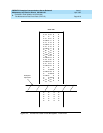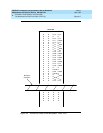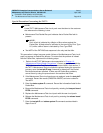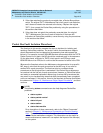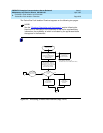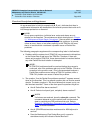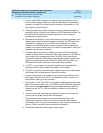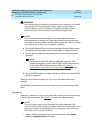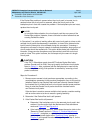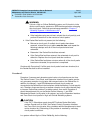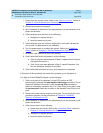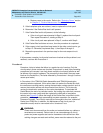
DEFINITY Enterprise Communications Server Release 5
Maintenance and Test for R5vs/si
555-230-123
Issue 1
April 1997
Packet Bus Fault Isolation and Correction
Page 9-24Packet Bus Fault Correction
9
Packet Bus Fault Correction
Using and Interpreting Results from the Status
System Command
The status system command can be issued to retrieve information about the
Packet Bus. This command is described fully in the "Status Commands" section
in Chapter 8, ‘‘
Maintenance Commands and Trouble-Clearing Aids’’.
The status system command provides the service state, alarm status, and (if the
Maintenance/Test Packet Bus port is activated) the number of faulty and open
leads. This information can be used to determine the urgency of the repair. In
general, a service state of ‘‘out’’ indicates extreme urgency, while a service state
of ‘‘reconfig’’ indicates moderate urgency.
!
CAUTION:
Ultimately, the urgency of a repair is determined by the customer’s
requirements. A customer who uses ISDN-BRI for station sets probably
considers a Packet Bus failure critical. However, a customer with only a
small percentage of ISDN-BRI service may consider even an uncorrectable
Packet Bus fault to be of minor importance and may prefer to delay
performing repairs, due to their destructive nature.
NOTE:
If maintenance is actively running on the Packet Bus at the time the status
system command is issued, the data reported for the Packet Bus may be
inconsistent. The reason is that this data is updated by the maintenance
tests that are running. If the data seems inconsistent, enter the command
again.
If test results or the results of the status system command indicate that there are
24 faults on the Packet Bus, the problem is probably caused by faulty cables
between carriers, or by defective bus terminators. However, before proceeding,
make sure that the report is not being falsely given by the Maintenance/Test
Packet Bus port. Accordingly, look for an M/T-PKT error in the error log. Then test
the Maintenance/Test Packet Bus port by entering the test port command. Refer
to the ‘‘
Special Precaution Concerning the TN771’’ section earlier in this chapter
if any problems are suspected.
If the carrier into which a TN771 Maintenance/Test circuit pack is installed does
not have a -5 volt power supply, the Maintenance/Test Packet Bus port reports
24 open leads on the Packet Bus (via the status system command and via Test
#572 of the PKT-BUS test sequence). No failure of the TN771 is indicated in this
case because the TN771 is not defective. Refer to CARR-POW maintenance in
Chapter 10, ‘‘
Maintenance Object Repair Procedures’’, and ensure that a -5 volt
power supply is available.



